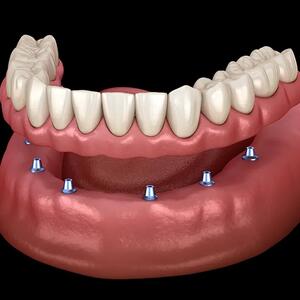Dental Bridge
Losing confidence due to missing teeth? Our article on dental bridges will help you learn more about how to regain a beautiful smile. Discover how these prostheses can restore your smile and the functionality of your teeth, preventing the shifting of adjacent teeth and bite misalignment.
What is a dental bridge?
A dental bridge is a fixed prosthetic device made to replace missing teeth. It consists of hollow crowns that are attached to prepared teeth and solid crowns that fill the gap where teeth are missing (sometimes with simulated gum tissue). The crowns of the bridge are installed on at least two or three prepared teeth or on implants.
Why is a dental bridge needed?
When one or two teeth are lost, the adjacent teeth may start to shift due to the chewing pressure. This can lead to bite misalignment, pain, or the loss of other teeth.
Dental Bridge - Before & After Photos

When is a Dental Bridge Necessary?
The need for a bridge arises with the loss of one or more teeth. Clinical examples include:
- Missing one or two canines or incisors in the front area.
- Loss of teeth in the chewing section, such as two molars or premolars.
- Terminal defect of the dental row, requiring implants.
The doctor assesses the situation and chooses the prosthesis method. The main requirement for a bridge is having two healthy supports. If teeth are unstable or severely damaged, the prosthesis is placed on implants.
How Many Teeth Can Be Replaced with a Bridge?
Bridges can range from 3 to 14 crowns. The orthodontic dentist selects the material and size of the bridge. After assessing the clinical situation, prosthetics are determined. If teeth are unstable or additional support is needed, the prosthesis is attached to implants. The treatment method is determined by the doctor.
Bridge on Prepared Teeth
When calculating the length of the bridge, not only the toothless areas but also the supporting teeth are considered. For example, a bridge for two missing teeth consists of 4 crowns. This approach is used henceforth.
Bridge of 3 Crowns
This is a standard type of bridge prosthesis that can be made from any material and is suitable for both the front and chewing parts of the jaw. A three-crown design minimizes the risk of breakage and simplifies repair. For the front area, E-max ceramic crowns are preferable, while for the chewing area, metal-ceramic or zirconium dioxide is recommended.
Bridge for 4 Teeth (4 Crowns)
The bridge is placed on two supports when two teeth are missing:
- on the outer incisors in the smile area;
- on the premolar and molar in the chewing section.
Such bridges can only be made from metal-ceramic or zirconium. E-max ceramic is not recommended due to its fragility, but there are exceptions.
Bridge for 5 or More Teeth
Bridges on two lateral supports are not installed; they are fixed only on several supporting teeth (at least three).
Constructions covering more than 5 teeth are used only to close multiple defects between healthy teeth (for example, when teeth are missing alternately, maximum – two consecutive). It is important to note that long bridges are not repairable, meaning that if one part breaks, the entire prosthesis must be replaced.
Exceptions to the Rules
In some clinical cases, dental rows are restored using long bridge prostheses. Elderly patients may sometimes receive a bridge for six or more teeth, if the teeth are not missing consecutively and there are no other treatment options. A zirconium bridge is fixed to the jaw, and the doctor advises the patient on the need for careful use (excluding hard foods from the diet).
Bridge on Implants
Bridge prosthetics are not suitable for replacing more than three consecutive missing teeth. Under chewing pressure, the teeth can become overloaded and loose, so extensive defects are corrected after implantation:
- For a completely toothless jaw, at least four implants with a prosthesis of ten crowns for the lower jaw or six implants with twelve crowns for the upper jaw are required. For the restoration of the jaw with the seventh teeth, eight rods and fourteen crowns are necessary.
- In the chewing area, two implants are placed with one gap.
- In the front area, the bridge is attached to four teeth supported by two or three.
How many teeth can be accommodated with a bridge?
Standard prosthetics include shorter constructions. Many dentists recommend installing a fixed dental bridge consisting of three crowns. Experience shows that longer prosthetic structures are more prone to breaking, have a shorter lifespan, and are more expensive to repair and replace.
Contraindications for Bridges
The installation of a dental bridge is not recommended in the following cases:
- Wide gaps in the dental row — missing more than four teeth in the smile line or two molars in the chewing area. The installation of a bridge is not recommended due to the risk of breakage.
- Abnormal bite (protruding jaw) and other jaw joint pathologies.
- Teeth with a short crown part — often found in small lateral incisors in the upper jaw.
- Terminal toothless gaps — missing the second molar (7) or the wisdom tooth (8).
- Dental diseases — caries, gum inflammation (gingivitis), periodontitis, periodontosis.
In such cases, the integrity and aesthetics of the dental row are restored using alternative methods.
Types of Dental Bridges
Bridges are made from various materials, each with its own characteristics in terms of lifespan, aesthetics, and strength. Almost all types of prostheses are suitable for the chewing area, but for the front area, it is important to choose materials with high aesthetics. Selection criteria:
- Bridge for the front teeth — crowns with natural transparency and color are used.
- Bridge for the molars — emphasis on functionality and strength.
Made of Zirconium Dioxide
Produced using CAD/CAM technology: blocks of zirconium dioxide are processed on a milling machine. Zirconium bridges are very strong and can withstand high chewing forces. Prostheses made of zirconium dioxide can include up to 12-14 crowns (unlike other types of metal-free ceramics, which are made no longer than three teeth).
Orthopedic Constructions Made of Zirconium Dioxide come in two types:
- Monolithic: Made from opaque zirconium block, hand-painted in white. They stand out in the dental row and are not suitable for front teeth. Recommended for the chewing part of the jaw on supporting teeth or implants.
- Multi-layer Monolithic: Produced from multi-layered zirconia blocks of the new generation. These blocks are stabilized with yttrium and have a color gradient similar to natural enamel. The crowns consist of four layers of transparency: opaque at the root, two transitional layers, and semi-transparent at the cutting edge. Multi-layer zirconium is only second to IPS E-max ceramics in aesthetics and is suitable for prosthetics in any area
IPS E-max Ceramics
IPS E-max ceramics are ideal for the front area of the mouth. Being fragile, ceramic bridges are not recommended for the chewing area. E-max ceramic bridges are better suited for the front teeth of the lower jaw, where the chewing load is minimal. Such bridges are less commonly used in the upper jaw.
In the front area, IPS E-max PRESS ceramics with high aesthetics and semi-transparent structure are used. Prostheses made of this ceramic blend harmoniously into the dental row.
Metal-Ceramic
Metal-ceramic bridges are less aesthetic: a metal framework is covered with a thick layer of porcelain, preventing a natural appearance. The difference from other teeth is usually noticeable. Metal-ceramic bridges are typically used for the molars.
In standard metal-ceramics, the edge of the crown contacts the gum, which can cause a bluish discoloration of the gums and allergic reactions. Improved metal-ceramics with "shoulder mass" do not affect the color of the gums, as the edge of the crown is isolated with an additional layer of ceramics. This improves aesthetics but increases the cost of installation.
Metal-ceramic bridges are not recommended for bite anomalies and advanced periodontitis.
Full-Cast Prostheses
Full-cast metal prostheses are made from a single piece of metal or combined with metal-ceramic crowns. They have low aesthetics but are strong and cost-effective. Such prostheses are suitable for the back molars that are not visible when smiling.
The use of full-cast prostheses is not recommended for front tooth defects and weak supporting teeth.
Adhesive Bridge Prostheses
This is a temporary solution that lasts up to two years. Adhesive bridge prosthesis is made in 1-1.5 hours directly in the patient's mouth from composite material. They are fixed to fiberglass bands or steel plates on the inner side of adjacent teeth.
Adhesive bridges are only used for single defects, excluding canines and molars (No. 3, 6, 7). When fixed on fiberglass, steps are created on adjacent teeth, affecting the integrity of healthy teeth.
Methods of Attaching Dental Bridges
On Prepared Teeth
Before fitting the bridge, the teeth are prepared as follows:
- For metal-ceramic bridges: 2-2.5 mm of the chewing surface and up to 2 mm of the side surfaces are removed.
- For ceramic bridges made of zirconium dioxide or E-max ceramics: 1.5 mm of the chewing surface and 1 mm of the side surfaces are reduced.
The longevity of the teeth depends on the amount of dentin removed. The less that is removed, the better the teeth are preserved.
The bridge is fixed onto the teeth using a cementing technique.
On Implants
Installing a bridge on implants is the best option if the budget allows and there are no contraindications for implantation. This method protects the health of adjacent teeth as it doesn't require reshaping or nerve removal. Prostheses on implants are more compact and durable. Artificial roots evenly distribute the load on the bone, preventing its atrophy and the shrinkage of the alveolar ridge.
Methods for attaching the bridge to implants:
- Cemented: Rarely used, as it is difficult to remove the bridge in case of a break.
- Screwed: A more reliable and safer method. A hole is drilled in the crown for screwing to the abutment, which is then covered with a filling. For adjustments, it is sufficient to remove the filling and screws. After corrections, the same bridge is reattached.
Advantages and disadvantages of bridge construction
Advantages
- Quick adaptation: acclimatization within 1-2 days.
- Affordable cost: due to a wide range of materials, it's less expensive than individual implantations.
- Fixed construction: does not affect speech and does not complicate chewing.
- Long lifespan: more than 10 years.
Disadvantages
- The pressure of the construction on the jaw leads to a decrease in gum level, visible as gaps in the smile area.
- A crown conceals the tooth defect, but without load on the jaw, bone tissue starts to diminish.
- Reshaping the enamel and removing the nerve reduces the durability of the support. A "dead" tooth decays faster.
Main Stages of Dental Bridge Installation
The dentist examines the oral cavity and identifies any contraindications. The patient undergoes an X-ray, OPG, or CT scan. Additional analyses are conducted if necessary. The dentist develops a treatment plan and selects the type of dental prosthesis.
The patient receives thorough cleaning from caries and plaque. Caries, gum inflammation, and periodontitis are treated.
The teeth are reshaped, the nerve is removed if necessary, canals are re-filled, and fillings are placed. If the support is weak, it is reinforced with a pin or inlay. Impressions of the jaw are taken.
The implants are placed into the jaw. Prosthetic work begins after the complete integration of the implants, formation of the gum contour, and securing of the abutments.
The dentist examines the prosthesis in the mouth, checking its color, transparency, fit to the gums, and correct occlusion. If any inaccuracies or discomfort are found, the prosthesis is adjusted and temporarily cemented.
The patient comes for the final check-up. The dentist adjusts the prosthesis according to the patient's sensations and permanently cements it.
Other Restoration Methods
If bridge prosthetics are not suitable, other treatment methods are used for individual and multiple tooth defects. For example, before implantation, if bone grafting is required and treatment is delayed, a temporary plastic removable prosthesis can be used. If the patient does not want to damage the supporting teeth or refuses implantation, a removable prosthetic option is chosen.
Removable prostheses are suitable for restoring partial defects or a completely lost row of teeth. There are two types of removable attachments:
- Fully removable: They are fixed on at least two supports without preparation. They restore 1-3 teeth in the upper or lower jaw.
- Partially removable with artificial gums: They are attached to the gums with suction cups or locks and hooks.
Removable prostheses are aesthetic, but have significant drawbacks: they reduce sensitivity, can affect speech, may fall out, and do not prevent bone atrophy. They are recommended for absolute contraindications to implantation or limited budget.
Questions and Answers
How long does a dental bridge last?
The lifespan of a dental bridge depends on the material and care. On average, it can last from 5 to 15 years.
Is the procedure of installing a dental bridge painful?
The installation of a dental bridge is usually carried out under local anesthesia, making the procedure virtually painless. Temporary discomfort and sensitivity may occur after the installation.
How much does a dental bridge cost?
The cost of a dental bridge varies depending on the material, the number of teeth being replaced, and the complexity of the procedure. Prices can vary significantly across different regions and clinics.
How do you care for a dental bridge?
Caring for a dental bridge involves regular teeth cleaning, using dental floss or special tools for cleaning under the bridge, and regular dental visits.
Can a dental bridge be installed on implants?
Yes, dental bridges can be installed on implants, which is a good solution for replacing several missing teeth.
What materials are used for making dental bridges?
Dental bridges can be made from various materials, including metal-ceramic, zirconium dioxide, and E-max ceramics. The choice of material depends on aesthetic preferences, functional requirements, and cost.


